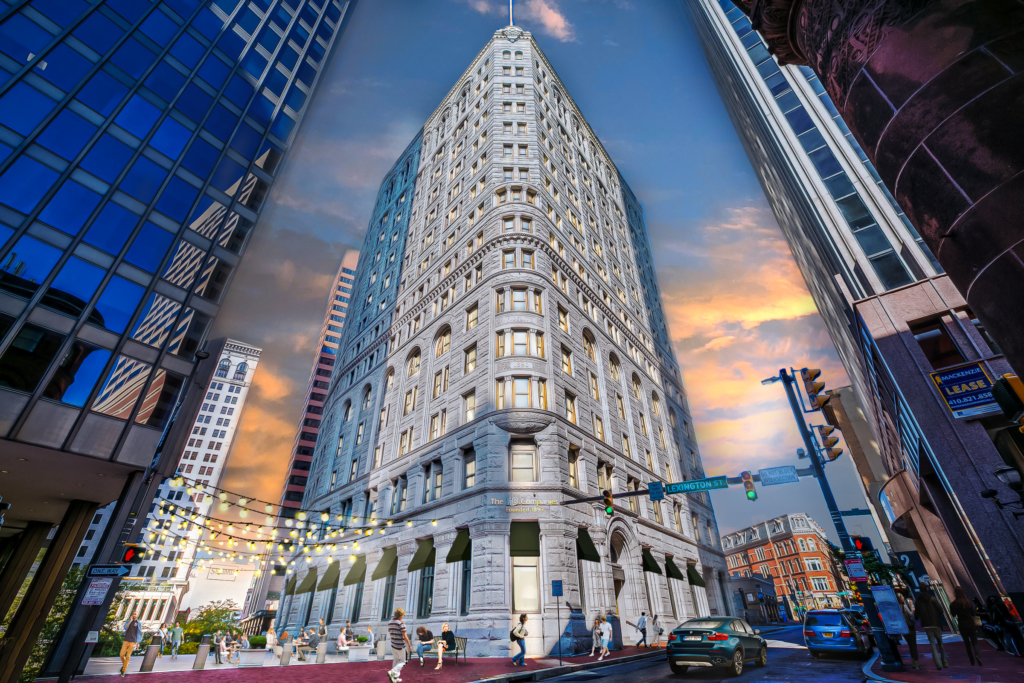The continued softness of the downtown commercial office market, aging office stock, success of the hybrid and work-from-home models, and the critical need for additional multifamily housing are collectively driving the sustained conversion of office buildings into apartment communities.
A high-profile example of this trend in Downtown Baltimore is the recent announcement to transform the 15-story, 232,000-square-foot Fidelity & Deposit Building on N. Charles Street into 220 apartment units. In addition, 300 West Fayette Street changed hands last summer, and the new owner immediately announced its intentions to convert the 120,000-square-foot office building into 107 market-rate apartments.
 Outdated and under-booked hotels are not immune to the trend. The Radisson Hotel Baltimore Downtown-Inner Harbor and the Holiday Inn Baltimore Inner Harbor recently sold in separate deals, with both slated to be converted to multifamily concepts.
Outdated and under-booked hotels are not immune to the trend. The Radisson Hotel Baltimore Downtown-Inner Harbor and the Holiday Inn Baltimore Inner Harbor recently sold in separate deals, with both slated to be converted to multifamily concepts.
The multifamily sector was among the most prolific performers during the healthcare crisis over the past two years as residents retreated to their homes and apartments to establish home offices during the mandated lockdown period and beyond. Many of these employees are expected to shift to hybrid work situations as employers continue to relax workplace guidelines and provide increased flexibility to their employee base. In addition, some companies with a downtown office presence are establishing a satellite location in the suburbs – to minimize commuting times and offer workplace options to their workforce. The smaller office footprints in urban areas are contributing to a glut of office space, with owners and investors investigating new ways to maximize the value of their assets. A conversion to multifamily often emerges as a viable answer.
Osprey Property Company acquired 22 Light Street in 2020 and immediately initiated plans to transform the project, also known as “The Lanahan Building,” into 40 workforce housing units. Within a few months of the conversion, the asset was 100% leased. Tyler Grote, Vice President of Osprey Property Company, explains that there existed a dire need for workforce housing in Baltimore City before the onset of the pandemic, which has only been exacerbated over the past two years.
Renewed vibrancy in Baltimore City
“The perfect storm of high office vacancy rates downtown, buildings outliving their original use and the steady increase of vibrancy in Baltimore City is fueling this trend,” Grote explained. “Taking on this conversion is not without its challenges as you can never predict the unknowns of an older building. In this case, the roof was in worse condition than we expected. This is not going to stop us from looking for additional opportunities because we believe downtown life in Baltimore City is becoming more appealing with 24-hour neighborhoods and younger people continuing to flow in. It all comes down to making the numbers work in any conversion project, such as we experienced with 22 Light Street. Osprey Property Company invested nearly $22 million into the project.”
Brad Byrnes of Byrnes & Associates, who brokered the sale of 22 Light Street and the Fidelity & Deposit Building and is also managing the leasing activities for several high-profile buildings downtown, sees the beginning of a renaissance in Baltimore City.
“Numerous economic fundamentals are driving the interest among multifamily and commercial office buyers in Downtown Baltimore, led by a significantly lower cost of living as compared to East Coast cities, less congestion, and access to Washington, D.C. and multiple beach resort cities,” Byrnes explained. “Both businesses and individuals remain optimistic about the future as conditions improve and more entities make significant investments in the city. This includes the approaching opening of the new $44-million Lexington Market renovation, as well as the impending $155 million improvements to the Royal Farms Arena. Across the board, investors are gaining more clarity on the City’s future as office workers slowly migrate back to downtown to add energy to the streets and activity to the restaurants.”
The trend is a national phenomenon. A recent article in GlobeSt.com suggested that “the combination of a housing crunch and a record office vacancy of more than 18 percent” is driving numerous office-to-apartment conversions in Washington, D.C., where multifamily vacancies hover at 3 percent as of year-end 2021.